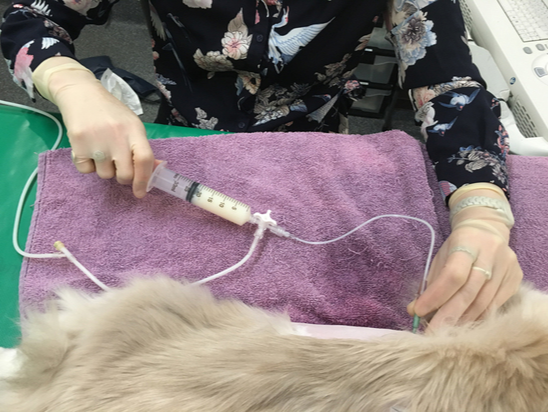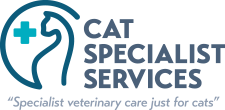What is thoracocentesis?
Thoracocentesis is a procedure performed to remove air or fluid from around the lungs where it shouldn't normally be.
How is it performed?
- Your cat is given a sedation or short anaesthetic to keep them still. This is not a painful procedure, however a needle is inserted into the chest where there are many structures, so keeping them still is very important.
- In addition, cat's with fluid or air around their lungs can be highly stressed and anxious due to their breathing difficulties so sedation helps them to relax and keep calm, which reduces the effort they need to breathe.
- Once your cat is sedated we typically clip the fur from their chest and use an ultrasound to identify the major area of fluid build up (or radiography for air).
- We clean the area and apply a local anaesthetic cream and sometimes an injection of local anaesthetic as well.
- We then guide a needle into the fluid pocket using the ultrasound and remove as much fluid (or air) as possible.
Is this an emergency?
Often yes, although it depends on how quickly the fluid has built up and how much there is. Often a cat will feel better immediately after the fluid has been drained and their breathing effort improves dramatically.
Why might a cat get fluid around their lungs?
- The most common reasons are heart disease, cancer and infections although there are other less common reasons.
- Investigating why the fluid has occurred is very important and typically requires an ultrasound of the heart (echocardiogram) to screen for heart disease and analysis of the fluid for cancer cells or other infectious agents such as bacteria.
Why might a cat get air leaking around their lungs?
Generally this is because of trauma or underlying airway disease such as asthma or cancer or a foreign body.
Is there a risk with thoracocentesis?
Yes, but unfortunately this is one of those procedures where the risk of the procedure is far outweighed by the life saving benefit of removing the air or fluid. The risk is that the needle can cut the lung causing further air leakage, or cut a blood vessel causing haemorrhage. In the rare event that this occurs the complications are typically mild and self limiting and the complications are less with the patient sedated or under anaesthesia.
Is the procedure painful?
In humans this procedure is done with a local anaesthetic. In cats, we have them under sedation or anaesthesia to keep them still, not because of the pain of the procedure. The needle size itself is the same size you would have a vaccination with so there shouldn't be any pain after the procedure is completed.
Can my cat go home afterwards?
It depends on the condition of your cat and how unwell they are. For some cats with chronic heart disease they can go home the same day. For other cats that are sicker they may need to stay in the hospital for longer while we try to investigate what is making them unwell and start treatments such as antibiotics or chemotherapy.
Will my cat need this procedure again?
- Sometimes. It depends on the underlying cause. For example cats with heart disease or with cancer can build up fluid on multiple occasions and feel much better after it is drained. For some cats (e.g. those with terminal cancer) we may even discuss placing a special port that enables easy drainage of the fluid to keep them comfortable.
- If we think your cat has a disease where fluid recurrence is likely, then we will teach you how to check their breathing rate at home when they are resting. You can also find a link to these instructions here.







